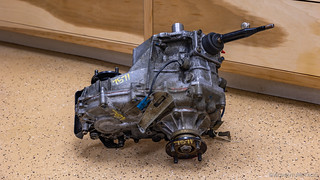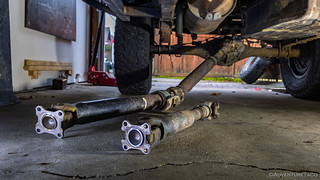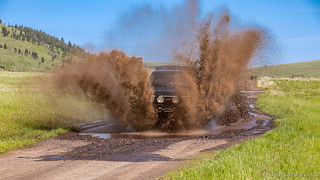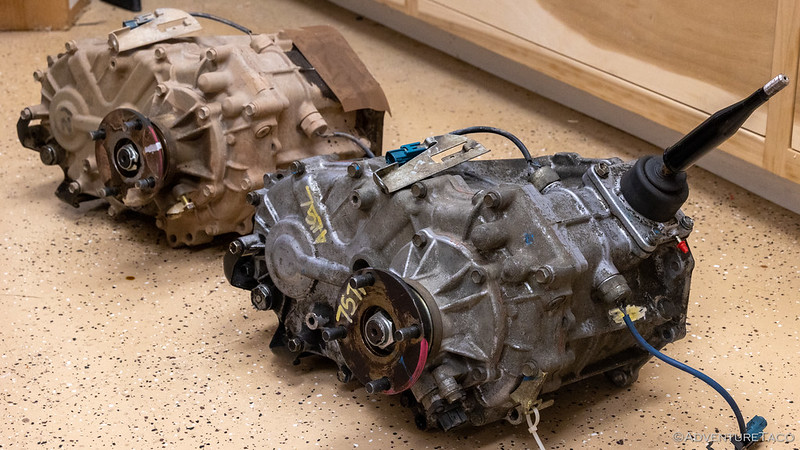By and large, the Tacoma has performed spectacularly over the 21 years since I drove it off the lot. With regular maintenance, I've really only had two or three failures - none of those failures requiring anything more than an early drive home - over the 200,000 miles it has travelled!
I suppose I can't always expect everything to work perfectly, and on my Back for More trip to Death Valley, I had a bad-enough-to-head-home-immediately failure of the transfer case. But, the story starts much, much earlier...
Background
It was in November 2018 - while on a trip to the Owyhee region of southeast Oregon - that the transfer case first started behaving badly. Approximately every three hours of 60mph highway driving, the transfer case would sound like it was suddenly spinning up - as though it engaged 4wd. The spinning would last for several seconds as I'd begin to slow down, and then, with a loud thunk, it would disengage and everything would be back to normal. Not sure what was going on, I "resolved" the issue for the remainder of the trip by periodically stopping and manually moving the J-shift of the transfer case between the various drive modes - thus ensuring that it was properly seated in 2-Hi (or so I hoped). Upon returning home, I quickly changed the oil in the case, and was appalled by the mud-colored goop that drained into my catch can.

Never the color you want to see draining out of your truck.
Since then - after a couple quick changes of the oil to clean everything out - the transfer case has gotten regular oil changes at intervals of about 30K miles. The oil has always looked fine, and except for seeming slightly louder in 4wd odes, it has never given me any more problems.
Just Like That, it's Over
It was on the third day of a trip in Death Valley - some 100K miles after the last time the transfer case had acted up - that I first sensed that anything was wrong. Descending Mengal Pass into Butte Valley, I heard what I would describe as a strange grinding sound from the gear-shift area of the Tacoma. Hoping that it was just something rubbing or bouncing because a bolt had come loose somewhere, I shifted the truck out of 4-Lo and into 4-Hi and pulled forward to a section of trail that was relatively smooth so I could get out to have a look.

Lucky me, not only was something wrong with the truck, but it was raining too! 
My search for a loose bolt on the skid plate, a lost nut on the limit straps, or a loose mount for the steering rack turned up nothing, and by the time I was climbing out from under the truck, my compatriots - Zane @Speedytech7, Monte @Blackdawg, and Mike @Digiratus - were all clustered along nearby, eager to know what was going on and how they could help.
After listening to the noise as I slowly drove by them, Zane was the first to offer an idea, "Sounds like you probably lost a tooth off one of the planetary gears in the doubler, and every time that spot rotates around, you hear it grinding into the other gears." Mike and Monte agreed that this sounded like a reasonable option - given that the sound only happened in 4-Lo - though Monte also suggested that it could be the shifter bushings of the transfer case, and that, "Maybe it's not really seated in the correct mode and you're getting a bit of grinding in 4-Lo."
Not really knowing what either of those meant, I inquired as to the longevity of the case in either condition. All three of the guys felt that I could probably finish out the trip - even if it meant using 2wd and 4-Hi for the remainder of our trails - and then fix the case upon my return home. And, I could check for the easy fix - by pulling the J-shift to see if the shifter bushing was worn - in camp the following morning.
That sounded great to me, and so we continued on - to one of my favorite camp sites in all of Death Valley - to Striped Butte.

Unfortunately, upon removing the shifter in the morning, the bushing was in perfect condition; we all assumed at this point that I'd lost a planetary gear in the doubler.
For the next 24 hours, the transfer case didn't act up at all and we had a fabulous day on the trail. However, the following morning - as we were rolling out of camp - the real grinding began. Much louder this time, it was certainly a spinning noise. Even worse, I was in 2-Hi as I was cruising down a rocky dirt road.
Still not really knowing how a transfer case worked, I let everyone know I was stopping and called Zane forward for another listen. Of course, all the guys were once again ready to help and Zane, Monte, and I all climbed under the truck to put our hands on the transfer case - which was clicking.
"Put the transfer case in neutral, the transmission in first, and let out the clutch," suggested Zane. I did, and the clicking got worse. In second gear, it got faster - so on and so forth through all the gears - and I got a sinking feeling in my stomach. "Definitely a bearing," said Zane, "Probably your input shaft bearing grinding itself to death." Monte concurred, "Looks like your trip is over."
Naturally, lots of questions came to my mind at this point -
- What is the input shaft bearing?
- Does this mean that the planetary gear in the doubler isn't the problem?
- What happens if the input shaft bearing disintegrates completely?
- How long will the bearing last now that it sounds like this?
- Will I be able to make it home?
After a few minutes of conversation, all my questions were answered to the best of everyone's ability and the general consensus was that I should be able to make it home - "though it might be the noisiest, most uncomfortable ride you've ever had," said Monte. As part of this conversation, Mike also mad the suggestion that we head home to the west - through California and I-5 - rather than via the shorter - but significantly more remote - route through Nevada. That would allow us easier access to a U-Haul trailer, should Zane need to tow my truck the rest of the way home.
I was bummed. But, I was also super glad to have such good buddies along to help.
In the end, everything they'd suggested about the trip home was right - I made it home under my own power, and it was the most uncomfortable drive I've ever endured, the horrible noise of the bearing spinning up startling me every few minutes, causing me to jump in my seat.
What to do Now?
I didn't do much on my first day home. I was tired from the 20-hour drive, and frankly I sort of wanted to ignore the problem. It wasn't until the following day that I started thinking through the best way to fix the problem. As I saw it, I had three options:
- Buy a new transfer case from Toyota and swap it in, knowing it was good.
- Buy a used transfer case from a junkyard; swap it in and hope it was good.
- Crack open my transfer case and try to fix it, then reinstall it and hope it was good.
I realized that my highest priority was getting the truck back in working order - so I whatever solution I came up with had to be fast. This mostly ruled out a strict rebuild, which Brett @Squeaky Penguin also suggested might be a bad idea - or at least more work than was worthwhile - if a bearing had grenaded and taken out other components with it. Plus, he reminded me, remember that mud that was in there for who-knows-how-long, and the havoc that it could have wreaked.
My inclination at that point was to purchase a new transfer case from Toyota. Sure, it was expensive at $2,453, but knowing that it would be a high-quality, brand-new part meant that it'd likely be trouble-free as well.
Unfortunately, replacement transfer cases for 1st gen Tacomas had been discontinued by Toyota years earlier.

Wah, wah.
And that left me with only one option: find a used transfer case, hopefully with relatively low miles; swap it into my truck, and then cross my fingers. Of course, I realized that whatever route I took, I also wanted to rebuild the original - doing so sounded like a few days of fun, and a lot of learning about the internals of my drive train.
So, I started asking questions on TacomaWorld. What kind of case did I need? Could other "versions" of the Tacoma transfer case be modified to work with my 4wd, MT, J-shift, w/Rear Diff Lock, w/ABS, w/ADD truck? Oh, and of course the most important question of all...
Anyone got a transfer case I can buy?
The outpouring of help from the TacomaWorld community was fantastic. So many people offered help and advice - some publicly, others in private - that it put a smile on my face and even (briefly) restored my faith in society and (parts of) the internet.
So, to Zane @Speedytech7, Monte @Blackdawg, Mike @Digiratus, Brett @BossFoss, Ryan @Reh5108, Brett @Squeaky Penguin, Mike @Area51Runner, @Lil Puke, @6P4, Andrew @04Pre_Runner, Dan @Empty_Lord, Austin @austinmtb and anyone I missed - a huge THANK YOU!
In the end, two bits of information were the most useful in helping me find a transfer case that I could use as a replacement. First - suggested by several people, but which Andrew @04Pre_Runner included illustrations for - was the details about the difference between M/T and A/T cases:

While the differences were identified, no one really knew why there were differences.
The second useful bit of info was that besides the transmission type and J-shift vs. and electronic 2wd/4wd selector, pretty much nothing else mattered. ADD, Rear Diff Lock, etc. are all supported via sensors that attach to the transfer case, and these sensors can be purchased separately if whatever case I bought needed one or more of them:

As usual, Toyota's descriptions of the sensors leave much to be desired; hopefully this helps.
Besides the sensors, there is a lot of confusion around transfer case identification in general. I've tried to provide lots of photos and examples in the Step-by-Step Replacing the Transfer Case on a Tacoma guide to make it easier moving forward.
All that information in hand, I had a new transfer case within 24 hours. Picked up at a local yard, it seemed to be exactly what I was looking for. With only 83K miles, it came off a Tacoma with a manual transmission and had a J-shift lever. Even better, it had all the same sensors as my existing case, so I wouldn't need to purchase - or swap them over - in order to get the new one installed.

What appears to be a perfect match! Let's hope that appearances aren't deceiving...
The Swap
With the new transfer case in hand, all I had left to do - at least, in order to get the truck back in working order - was to swap it in for the old one. This meant finding a day or two where I could work on the truck - ideally out of the cold and rain of the Pacific Northwest. Unfortunately, cold and rain are the standard operating environment for most of the year - and especially at the end of December - so it was just after Christmas that I decided to attempt the work in the garage. I'd recently patched my rear axle housing in the cramped space, and hoped that I'd be just as successful swapping out the transfer case.

I started by draining the oil out of the case. A bit of a bummer since I'd just put new oil in about 7500 miles earlier.
With the oil drained into a plastic milk jug so I could inspect it later, the next step was to separate the case from the output shafts - one to the rear diff and one to the front. These, I marked with a paint pen - at both ends and at the spline - so that I'd know the original orientation. Only the spline mark really matters - and then only if I separate the halves for some reason - since I was installing an entirely new case - and pulled out relatively easily.

Good Practice.

No-Wheel-Drive Tacoma. Still more capable than a Jeep. 

Output shafts removed, I disconnected the various plugs from the transfer case and removed the J-shift inside the cab. All that was left was to unbolt the case from the transmission and carefully lower it to the ground.

There were two plugs to disconnect. A relatively straight forward task given that I'd washed the underside of the truck after the last trip.

The speedo gear also came out and went into a baggie, since it was covering me in more disgusting gear oil. Seriously, why does this crap smell so bad?

Four (4) screws, and four (4) bolts were all that was needed to remove the shroud over the J-shift.

Supporting the case with the floor jack made it a reasonably safe operation to lower it to the ground after removing the eight (8) 14mm aluminum bolts.
With my old case removed, I followed a best practice I've seen listed several times in the Toyota Factory Service Manual and compared the old and new parts. Except for a little dirt here and a little rust there, they mostly looked the same and I carried on with the swap.

Amazing how differently colored my 200K mile case (left) looks compared to the 85K mile case (right). Someone's been playing in the dirt. 
Installation was essentially the reverse of removal - though I did nearly drop the new case off the transmission jack and onto my head about four times as I wrangled it into position.

Fourth time was a charm.
Before long everything was bolted up, plugged in, oiled up, and - hopefully - ready to test!
It Actually Seems to be Working
I can't tell you how relieved I was when everything seemed to work upon rolling out of the garage. I still couldn't really believe it when I drove the first ten miles on the highway - the bearings in the new transfer case functioning as they should - without any of the drama I'd experienced on the way home from Death Valley. It was splendid.
Of course, I know almost nothing about this transfer case, so who knows if it'll last me 100- or 500,000-miles, but it certainly seems good enough to keep me on the trail while I attempt a rebuild of the original. And then, perhaps, I'll swap them again to rebuild the new case - giving myself two cases in known condition, on the off chance that something goes drastically wrong in the future.
For now though, I'm a happy camper (literally), once again able to get out there and explore!

First things first, let's get the transfer case to be the correct color. 
But Wait, What About the Oil from the Original Case?
For those that remember, I'd carefully drained the gear oil from the original case into a 1-gallon milk jug so I could have a look at it later - you know, to see if there were any little bits of metal in there. Turns out, I also swapped out the oil from the replacement transfer case relatively quickly as well - just in case there were any contaminants introduced at the junkyard, and so I had two batches of oil to test.
My plan was to wait for a nice warm day, but after a week or so, I realized I could be waiting several months for such a rare event - so I brought the two containers of oil into the basement and checked them out there.

Lighter colored (after ~50 miles), new transfer case oil on the left; original, darker colored oil (after ~7500 miles) from the original transfer case on the right. Nothing too surprising yet.

As the oil begins to drain... look at the sparkles!

More draining.

That'd be a pretty good pan if I were a gold miner.
So, there's clearly something eating itself up in the original transfer case - likely at least the input shaft bearing. As the weather warms up, I'll dig into that puppy to see what's going on.
The oil from the new case looks pretty reasonable - at least for now - another indication that things are likely on the up-and-up. Whew!
For anyone else who needs to replace a transfer case, I have a ton more photos - both educational and of the process - to help with the job in a step-by-step guide I put together for the swap.
The Saga of the Transfer Case




Congrats. Looks good. Glad you found one. Great write up as always.
Thanks Sean! And, I'm glad to report that after two trips (about 5500 miles) the new case seems to be working perfectly! Chalk up a win on that one, and when it gets a little warmer (since I'll be doing it in an unheated garage), I'll break open the original case to see all the drama in there!
An awesome story with a happy ending too. I can't wait to see when you break open the original transfer case and expose its guts. Please video it. This story made me feel better as I won't complain that I can't get my 2002 Tacoma California smogged because a stubborn CAT monitor won't turn on. I will be back on SoCal freeways and try another driver pattern to turn on my CAT monitor.
Thanks Christian, glad you liked the story. I probably won't take a video of opening up the old case, but there will be plenty of photos for sure! Good luck with the smog, we got lucky and don't have to do that up here anymore! ?
"...more capable than a Jeep".
Lol! Good one, Dan!
ps. Glad I drive a GMC Sierra....grins...
David
Gotta poke a little fun when you can! ? All in good spirit of course - I grew up in Jeeps and still have my eye on a CJ5 that's my uncle has had since he was 20, and I'm hoping to fix up with him some day.
Agreed!
The CJ5 would be fun to work on!!!
Glad your transfer case in working for you!
D